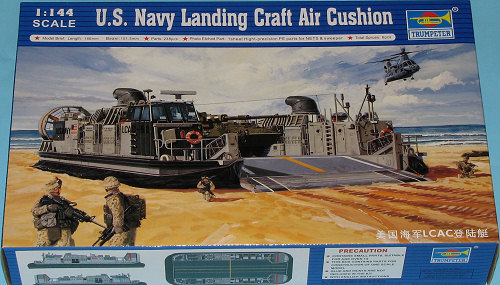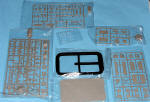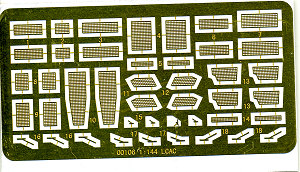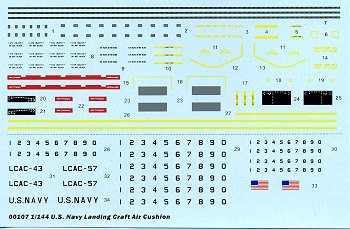
| KIT: | Trumpeter 1/144 USN LCAC |
| KIT #: | 00107 |
| PRICE: | $35.95 SRP |
| DECALS: | many options |
| REVIEWER: | Scott Van Aken |
| NOTES: |

| HISTORY |
The landing craft air cushion (LCAC) is a high-speed, over-the-beach fully amphibious landing craft capable of carrying a 60-75 ton payload. It is used to transport weapons systems, equipment, cargo and personnel from ship to shore and across the beach. The advantages of air-cushion landing craft are numerous. They can carry heavy payloads, such as an M-1 tank, at high speeds. Their payload and speed mean more forces reach the shore in a shorter time, with shorter intervals between trips. The air cushion allows this vehicle to reach more than 70 percent of the world's coastline compared to only 17% with conventional landing craft.
LCAC was developed to satisfy the need for an air cushion landing craft capable of carrying troops, artillery, tanks, combat vehicles, and other major items of combat and combat support equipment across the beach. LCAC is the production follow-on to earlier advanced development craft which were tested by the Navy between 1977 and 1981.On June 29, 1987, LCAC was granted approval for full production. Forty-eight air-cushion landing craft were authorized and appropriated through FY 89. Lockheed Shipbuilding Company was competitively selected as a second source. The FY 1990 budget request included $219.3 million for nine craft. The FY 1991 request included full funding for 12 LCACs and advance procurement in support of the FY 1992 program (which was intended to be nine craft). The remaining 24 were funded in FY92. As of December 1995, 82 LCACs had been delivered to the Navy.
Initially, all testing had been conducted in Panama City, FL. Subsequently, the LCAC was tested in California, Australia, and in Arctic waters. Rough weather conditions forced cancellation of Exercise Valiant Usher 89-4, a joint U.S.-Australian amphibious assault exercise to be conducted off the northern Australian coastline. Objectives for tests in Alaska in March 1992 included evaluating all operational effectiveness and suitability concerns of multiple LCAC in an arctic environment. LCAC was neither operationally effective or suitable for arctic operations, and merely correcting the cold weather kit design would not be sufficient to conclude that LCAC was operationally effective and suitable in an arctic environment. Performance in opposed scenarios and in severe cold weather conditions would be necessary to fully evaluate LCAC performance. DOT&E recommended further operational testing. Developmental tests indicated that at colder temperatures engine power increases until gearbox torque limits capability, but icing and sea state would reduce that capability. Since then, LCAC has been used in two arctic exercises, one of which included operations in weather down to 15°F and realistic sortie rates. Based on this exercise, DOT&E concluded that further operational testing would not be necessary. LCAC demonstrated the ability to travel over light ice and open water, in fairly calm seas. The distance traveled per sortie ranged from 3-10 miles each way. Icing, which occurred in some conditions, also requires periodic interruption of missions to remove ice. JP-5 fuel was used, which alleviated problems with filters clogging. Also, LCAC has been involved in several minesweeping exercises, it has shown itself to be a potentially effective minesweeper in very shallow water. While this was not the original intent of the program, the system offers significant potential for enhancing force readiness.
The first deployment of LCAC occurred in 1987 with LCAC 02/03/04 embarked in USS GERMANTOWN (LSD 42). In July 1987 LCAC 04 transited Buckner Bay, Okinawa and conducted the first LCAC landing on foreign soil. The largest deployment of LCAC took place in January 1991 with four detachments consisting of eleven craft reporting for duty in the Persian Gulf in support of Operation Desert Storm.
The similarities between a Navy LCAC and an airplane are substantial. The craftmaster sits in a "cockpit" or command module with a headset radio on. He talks to air traffic control which for LCAC's is well-deck control located near a ship's sterngate. The ride feels like a plane in high turbulence. The craftmaster steers with a yoke, his feet are on rudder controls -- and he flies a lot like a hockey puck on an air hockey table. The LCAC is similar to a helicopter in that it has six dimensions of motion.
Late Note (2010): A reader offers this additional information
| THE KIT |
 You have to give Trumpeter credit for offering interesting and unusual kits. This one of the Navy's LCAC is a case in point. Molded in Trumpeter's usual medium grey plastic, the sprues are indivudually packaged, aside from on package containing two identical sprues. A large vinyl air cushion is also supplied. This appears to be in the full inflated position. Perhaps offering it in a deflated condition as it would be on a beach would have been a better choice for realistically modelling this under power in a haze of spray will be quite a challenge.
You have to give Trumpeter credit for offering interesting and unusual kits. This one of the Navy's LCAC is a case in point. Molded in Trumpeter's usual medium grey plastic, the sprues are indivudually packaged, aside from on package containing two identical sprues. A large vinyl air cushion is also supplied. This appears to be in the full inflated position. Perhaps offering it in a deflated condition as it would be on a beach would have been a better choice for realistically modelling this under power in a haze of spray will be quite a challenge.
For those not familiar with these vehicles, all of the power and control sections are on either side of the vehicle with each side powering a huge shrouded fan. The center of it is left open for the loading and unloading of troops and equipment. That being the case, the kit consists of three major builds. One is of the main body of the LCAC itself. The other two are of all the bits that fit on the left and right sides. This consists of several modules comprising the control section, engine section, transmission section and the shrouded fan. Each of these are built up separately and then joined to the hull at the final construction step.
A very nicely done photo-etch set is also included. This is quite appropriate for this vehicle as the LCAC has a lot of screening and p.e. is perfect for replicating this. There are also a number of windscreen wipers on the fret as these are a mandatory part of the LCAC due to all the spray that is kicked up.
 The instructions are very well done and show exactly where all the bits and pieces are attached. There is a separate color painting sheet included that is keyed to Gunze colors. From the look of things, the superstructure is painted silver while the hull is in a dark grey with various pieces in other shades of grey. The decal sheet is quite extensive as there are a lot of ID and warning markings to be applied. There are ready to use codes for LCAC 43 and 57 with additional color differences shown for LCAC 71. With the plethora of additional numbers, one could probably do any of the current fleet. Decals are well printed and should give good service. Though they do have a reputation for not being the best, there really is no other option.
The instructions are very well done and show exactly where all the bits and pieces are attached. There is a separate color painting sheet included that is keyed to Gunze colors. From the look of things, the superstructure is painted silver while the hull is in a dark grey with various pieces in other shades of grey. The decal sheet is quite extensive as there are a lot of ID and warning markings to be applied. There are ready to use codes for LCAC 43 and 57 with additional color differences shown for LCAC 71. With the plethora of additional numbers, one could probably do any of the current fleet. Decals are well printed and should give good service. Though they do have a reputation for not being the best, there really is no other option.
| CONCLUSIONS |
So there you have it. Another interesting subject and one that should spark some interest in providing scale 1/144 modern armor and other bits to go along with it.
| REFERENCES |
Review kit courtesy of Stevens International, importer of Trumpeter kit.
August 2007
If you would like your product reviewed fairly and quickly by asite that has nearly 400,000 visitors a month, please contactme or see other details in the